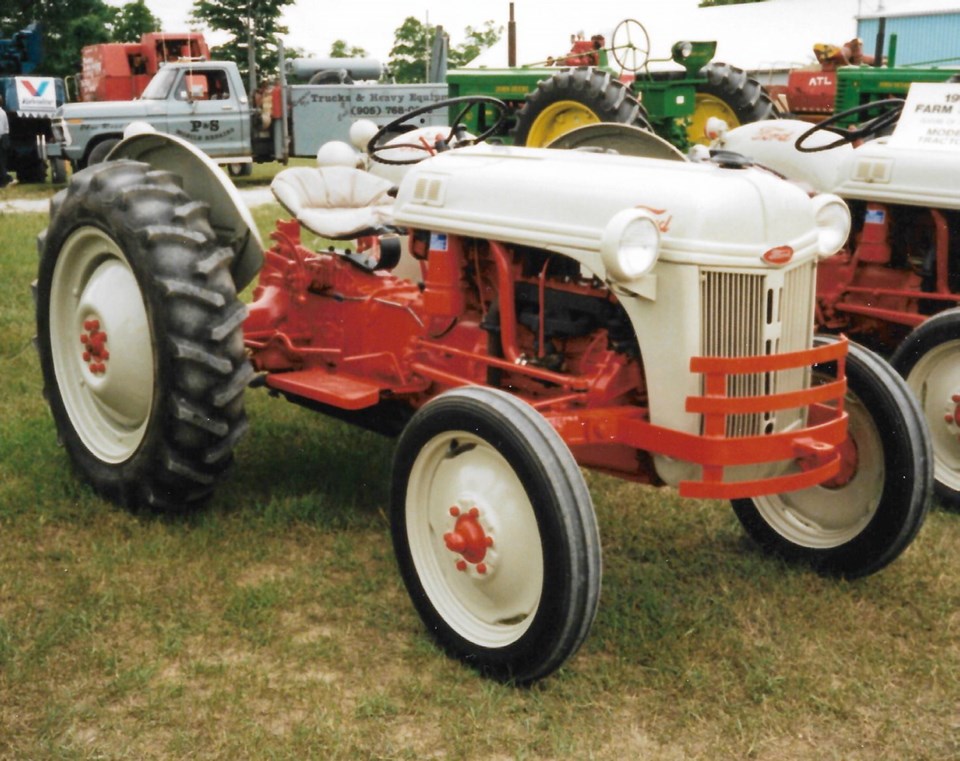While Henry Ford’s more than 15 million Model T cars built from 1908 to 1927 put much of the world on wheels, Henry Ford’s tractors also had a major impact on farming.
Early tractors were heavy, often steam-powered “road locomotives” that required a skilled operator. They were too big and awkward for most farm work, and were typically used for tasks such as hauling grain separators from farm to farm and powering them for threshings.
Gasoline engines changed that. According to Robert Pripps’ book Vintage Ford Tractors, Charles Hart and Charles Parr built the first production gasoline-powered “tractor” (a name they coined) in 1902 in Charles City, Iowa.
Gasoline tractors were smaller, lighter, more manoeuvrable and easier to operate that the road locomotives. The Hart-Parr started a tractor revolution, and others such as International Harvester, Massey-Harris, John Deere and Ford followed.
Ford began experimenting with four-cylinder car-engine tractors in 1906, but the Model T’s explosive success delayed their development. The Fordson tractor was finally announced in 1917, and dominated the tractor market until the arrival of International Harvester’s 1924 rowcrop Farmall.
When the First World War endangered grain shipments to Britain between 1914 and 1918, the British government was desperate for tractors to increase production. Fordsons shipped to England became so popular that when they were becoming obsolete in North America in the late 1920s, production was moved to Cork, Ireland, then Dagenham, Essex, England, where they were made until 1938.
Through Fordson exports, Ford’s chief executive Charles Sorensen met young Harry Ferguson, a mercurial Irish farm-implement salesman and inventor. In his book My Forty Years With Ford, Sorensen wrote: “Had I been able to foresee the consequence of that meeting, I would have avoided it.”
In 1938, Ferguson demonstrated his David Brown-built, Fordson-inspired Ferguson tractor to Henry Ford. It featured Ferguson’s three-point hydraulic hitch, which effectively made the tractor and implement one unit.
When an aging Ford was unsuccessful in buying the patent, he made a handshake “gentleman’s agreement” with Ferguson, much to Ford management’s dismay. It specified that Ford would manufacture tractors with Ferguson’s hitch, and Ferguson would market them and design the implements, although Ford’s engineers ultimately ended up designing them after Ferguson’s proved unsuitable for North America.
Ford’s managers thought Ferguson had outfoxed Ford, an opinion vindicated by history. According to Ford N-Series design engineer Harold Brock: “Over the years, Ford lost approximately $9 million producing tractors for Ferguson to distribute, while Ferguson made about the same amount. Ferguson’s investment was a few typewriters and a distribution headquarters in the middle of Ford’s Rouge plant.”
The Ford-Ferguson N-Series began with the 1939 9N (9 for 1939). Its side-valve, four-cylinder engine used many Ford V-8 components. The same 77.8 x 95.2 mm bore and stroke gave 1.8-litre displacement, half the V-8’s. It developed 28 flywheel horsepower at 2,000 rpm, and a 1940 University of Nebraska test recorded a respectable 16.3 drawbar horsepower and 23.6 belt horsepower.
The real story, however, was Ferguson’s three-point hitch. Two arms pulling below the axle and one pushing above made the 9N perform like a larger tractor. When plowing, some of the mounted plow’s weight was transferred to the tractor’s rear wheels, giving improved traction.
Ferguson’s second ingenious feature was automatic draft control. When a predetermined drawing force was reached, the upper arm compressed a draft-load-sensing spring under the seat. This signalled the hydraulic system to adjust plow depth to compensate for soil resistance or tractor attitude. Automatic draft control matched the average draft with the tractor’s power and tractive ability. The three-point hitch and draft control were major tractor advances.
The 9N’s tracks could be changed for different crop row spacing by adjusting the length of the three-piece front beam axle and reversing the rear dished wheels. Downward extending kingpins added ground clearance. A starter, rubber tires and power take-off were standard.
The Ford-Ferguson 9N was made until 1942, then replaced by the more basic 2N during the Second World War. The 1947 8N superseded the 2N, proving so popular that Ford tractor sales reached a 20-year high. It was replaced by Ford’s 1953 NAA 50th anniversary Golden Jubilee model.
After Ford’s new management cancelled the handshake agreement in 1947, Ferguson launched a competitive tractor similar to Ford’s. Built by England’s Standard Motor Co., its engines included the 2.1-litre overhead-valve four used in Vanguard, Triumph and Morgan cars.
Ferguson sued Ford for $341 million US for, among other things, breaking the agreement and patent infringement. Ford president Henry Ford II settled out of court for $9.25 million in 1952.
Although Ford built many tractors before and after the N-Series, that sturdy little machine was named Tractor of the Century. Many are still in use 70 years later.


